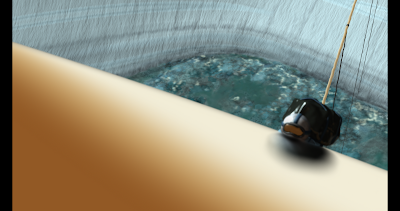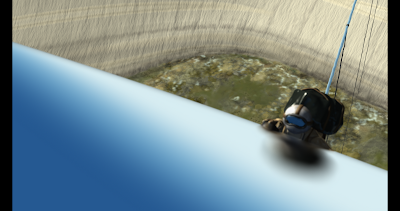Here are the steps I followed to produce a DCP for the 11-minute short film
The Incident at Tower 37. It has ingested and played properly on a Doremi DCP-2000. The projector was a Barco model. Everything below was done on a Linux machine.
Credit where it is due: as I mentioned in an earlier post, I'm building off the work of the people behind
asdcplib and
OpenCinemaTools, and the users on the
Red user forums who have published software and instructions that they have used/created while traversing this bumpy path. Big thanks to Wolfgang, Pavel, Marc, Samson, and Josiah.
In the interest of brevity, I'm not going to explain why I chose program X over program Y -- those interested can read my previous posts where I go into more of those details. Also, I'm not trying to present the be-all, end-all DCP manual here; this is just what worked for me!
Step 0: prepare sources
My source video was a 24fps lossless QuickTime movie, 1920 x 1080 (16:9). For the purposes of this document, call it INMOVIE.mov.
My source audio comprised of six wav files for Dolby 5.1 surround, each 48kHz mono.
Step 1: export PNGs from source QuickTime movie
Tool:
ffmpeg
Version: SVN-r21770 (compiled locally)
Command:
ffmpeg -r 24 -i INMOVIE.mov -f image2 %08d.png
This marches through the video file outputting a lossless, compressed PNG 24 times per second.
Step 2: convert to 12 bit per channel XYZ color images
Tool:
ImageMagick's convert
Version: 6.5.9 (compiled locally)
Must be run once per PNG frame.
Command:
convert FRAME.png -type TrueColor -alpha Off \
-background black -extent 2048x1080-64 -depth 12 \
-gamma 0.454545 \
-recolor "0.4124564 0.3575761 0.1804375 \
0.2126729 0.7151522 0.0721750 \
0.0193339 0.1191920 0.9503041" \
-gamma 2.6 FRAME.tif
This takes a 1920 x 1080 PNG from step 1, removes any alpha, pads the image with 64 pixels of black on each side so that it becomes 2048 x 1080, sets the bit depth to 12 bits per pixel, and does a linear-space color shift from RGB->XYZ. Then it writes the image out as a TIFF.
Upon
further reading, I interrogated my own decision to force the 1920 x 1080 images into a 2048 x 1080 container by padding with black. Apparently, you only need one dimension of the source imagery to match either 2048 or 1080 and the OpenJPEG encoder will do the right thing.
The new conversion line I used today omits the padding and looked stellar at the theater just moments ago:
convert FRAME.png -type TrueColor -alpha Off -depth 12 \
-gamma 0.454545 \
-recolor "0.4124564 0.3575761 0.1804375 \
0.2126729 0.7151522 0.0721750 \
0.0193339 0.1191920 0.9503041" \
-gamma 2.6 FRAME.tif
This must be run one frame at a time, but it's very easy to distribute ranges of frames to multiple processors if you have them.
Step 3: convert TIFFs to JPEG-2000
Tool:
OpenJPEG's image_to_j2k
Version: 2.1.3.0(compiled locally from
subversion revision 543)
Must be run once per TIFF frame.
Command:
image_to_j2k -cinema2K 24 -i FRAME.tif -o FRAME.j2c
This takes longer per frame than convert, in my experience. About 2x longer. Also easy to distribute to many machines, however.
Step 4: make all the necessary DCP files
Tools:
OpenCinemaTools
Version: 1.1.2 (compiled locally)
This step has five substeps, each of which generates one or more of the files needed for the DCP. Naming conventions are very important in DCP land, so I highly recommend that you
read about them yourself and make informed choices. When you see DCPFULLNAME below, that's shorthand for what I used, which was the mouthful:
TOWER37_FTR_F_EN-XX_US-XX_51_2K_ST_20100212_OV
Command A (create a video MXF file from the folder of J2K files):
asdcptest -v -L -c PROJ.video.mxf FOLDER_OF_J2KS
Command B (create an audio MXF file from the six wavs):
asdcptest -v -L -c PROJ.audio.mxf left.wav right.wav \
center.wav sub.wav surrLeft.wav surrRight.wav
Command C (create an XML composition playlist):
mkcpl --kind feature --title DCPFULLNAME \
--annotation DCPFULLNAME --norating \
PROJ.video.mxf PROJ.audio.mxf > PROJ.cpl.xml
Do check the output of command C and confirm that the durations of both video and audio are identical. The XML tag for this is "IntrinsicDuration."
Command D (create an XML packing list):
mkpkl --issuer BitFilms --annotation DCPFULLNAME \ PROJ.video.mxf PROJ.audio.mxf PROJ.cpl.xml > PROJ.pkl.xml
Command E (create the ASSETMAP and VOLINDEX XML files):
mkmap --issuer BitFilms \PROJ.video.mxf PROJ.audio.mxf PROJ.cpl.xml PROJ.pkl.xml
I used a bit of shorthand above since I did not identify enclosing folders. I suggest that if you make a DCP this way, you use temporary folders for all the inputs (and the results of steps 1-3), then create a finalDCP folder which you populate with only the files that will be part of the eventual DCP itself (namely, the 2 mxfs and the 4 XML files that come from step 4).
Step 5: Get the DCP onto a Hard Drive
Tools: regular linux shell
I need to get the specific instructions from Josiah, but basically we formatted a UDF disk solely for the purpose of holding the DCP (partition type 0x83 if I remember correctly). Then I copied over the 6 files that emerged from step 4 right to the root of the new disk. And it's done!
Some quick notes:
- It is important that you check your XML files to make sure the file paths don't contain any incorrect information: if you aren't careful during step 4, your file paths in the XML may be incorrect! Here's what one of my entries looks like in my final ASSETMAP.xml file as an example: file:///tower37_complete3.video.mxf
- I don't know what happens if your audio and video durations are different, so I was careful to make sure mine were not. Check them in the CPL (the tag is ).
- Work with a small movie file for starters, a minute or less, until you get the steps ironed out. Then move to your full film.
I hope this is useful for some of you! If you see any mistakes above, or have suggestions to improve or generalize this pipeline, please let me know.



















